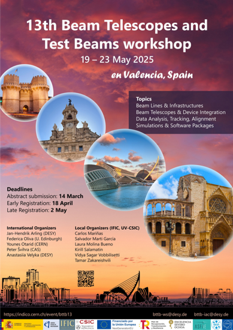Speaker
Description
The expected luminosity increase at the High-Luminosity phase of the LHC (HL-LHC), with instantaneous luminosities up $7.5 \times 10^{34}~\mathrm{cm}^{−2}\mathrm{s}^{−1}$, will be a challenge to the
performance of the ATLAS detector. The pile-up is expected to increase to up to 200 interactions per bunch crossing, resulting in degraded performance of the currently used reconstruction and trigger algorithms in the endcap and forward regions of the detector. To mitigate these pile-up effects, the High-Granularity Timing Detector (HGTD) will be integrated into the endcap regions, between the new Inner Tracker (ITk) and the calorimeter cryostat, covering the pseudorapidity range of $2.4 < |\eta|< 4.0$. HGTD aims for a single-track time resolution for minimum-ionizing particles of 30 ps at the beginning of the lifetime, up to 50 ps after the maximum fluence of $2.5 \times 10^{15}$ n$_\mathrm{eq}/\mathrm{cm}^2$. The high-precision timing information improves the capability to correctly assign tracks to vertex.
HGTD consists of 8032 modules, each $2\times4$ cm$^2$ composed of two silicon sensors bump-bonded to the ASICs and glued to a PCB. The HGTD sensors are based on the Low-Gain Avalanche Detector (LGAD) technology. Each sensor is a $15\times15$ array of $1.3\times1.3$ mm$^2$ LGAD pads, adding up to 3.6 million read-out channels in total.
Several test beam campaigns have been carried out at the CERN SPS and at DESY to study the performance of the sensors, hybrids and modules. Moreover, a Sr-90 timing testing set-up for hybrids and modules has been deployed at CERN, enabling continuous measurements, complementary to test beam campaigns. This contribution will focus on the latest test beam and Sr-90 results for hybrids.
